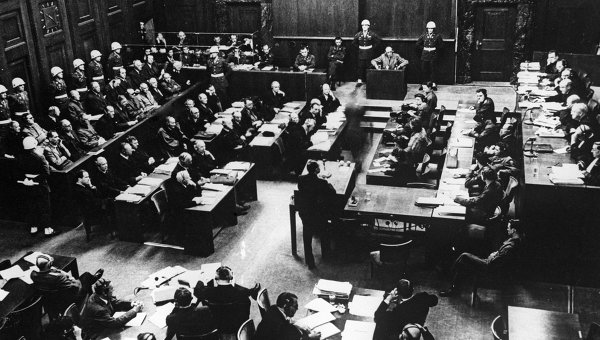 |
| Nuremberg Trials |
The Nuremberg Trials generally refers to the trials against members of the German leadership for war crimes committed in the period leading up to and during World War II. The decision to try these individuals was made during the war.
In 1943, President Franklin D. Roosevelt of the United States, Prime Minister Winston Churchill of Great Britain, and Joseph Stalin of the USSR proclaimed in the Moscow Declaration, the intent to hold the German leadership responsible for their actions associated with the war. That same year, the initial meeting of the United Nations War Crimes Commission met in London to address the issue.
Although there were differing opinions regarding the scope of the trials, the procedural framework, and the substantive nature of the charges, the ultimate decision was made to prosecute roughly 20 members of German government, military, and industry for their involvement in the war. The main portion of the proceedings was held from November 1945 until August 1946 at the Palace of Justice in Nuremberg.
  |
The Nuremberg Trials were an ambitious undertaking. At the time the charges were brought, there was little, if any, precedent for these charges in international law. The four-count indictment sought to hold accountable not just the individual heads of the Nazi regime, but also the various governmental units. The first count alleged, essentially, that the defendants acted in a conspiracy to commit crimes against peace, war crimes, and crimes against humanity.
The second count claimed the defendants engaged in a war of aggression. The third count set out that the defendants had a common plan to commit war crimes. The fourth count alleged crimes against humanity, which included the claim that the defendants persecuted civilians on political, racial, and religious grounds.
Like the substantive charges in the indictment, the procedure by which the defendants would be charged and tried was something unheard of at the time. Because the British, American, French, and Soviet forces had divided the conquered Germany, each country attempted to influence the manner in which the defendants were to be tried.
Four prosecutorial teams assembled to address the charges, and there were four judges, as well as alternates, from the four representative nations. The logistics of holding the proceedings were also daunting.
Hundreds of thousands of pages of documents were entered into evidence, and over 100 witnesses testified. Because the prosecutors and the judges presiding over the tribunal were from the representative countries, all communications at the trial needed to be translated into English, French, German, and Russian.
The individual defendants were carefully selected so as to represent various segments of the Nazi regime. The defendants were members of the military and government and heads of industry. With Adolf Hitler having committed suicide, the most prominent defendant was Hermann Göring, the commander in chief of the Luftwaffe, or German air force, and president of the Reichstag.
Wilhelm Keitel was the chief of staff of the supreme command of the armed forces. Karl Doenitz, commander in chief of the navy, was Hitler's successor. One person charged, Robert Ley, committed suicide before he could be tried, and two were ultimately deemed unfit to stand trial.
All in all, there were 22 named defendants tried, including Martin Bormann, who was tried in absentia. Although the majority of the defendants were convicted, a few were acquitted of some or all of the charges against them. Sentences ranged from death by hanging to imprisonment.
Although the Nuremberg Trials generally refer to the initial trial, there were, in fact, 12 follow-up trials involving other lesser-ranking members of the German government involved in various war crimes and human rights abuses.
Although some legal scholars challenge the legitimacy of the trials, they served as a detailed review of the atrocities committed by the German government in World War II. The Nuremberg Trials have served as a model for subsequent war crimes tribunals.